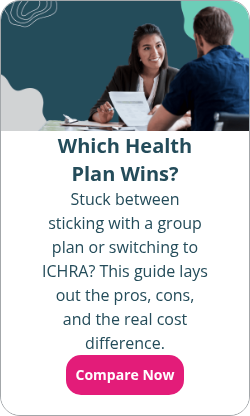Guide to ACA employer penalties
By Chase Charaba on May 1, 2025 at 11:20 AM
If you employ workers in the United States, it's important to understand the Affordable Care Act's (ACA) employer mandate and the potential penalties that come with it.
Under federal law, all organizations with 50 or more full-time equivalent employees (FTEs) must offer qualifying health insurance to their workers. If you fail to do so, you may have to pay a penalty.
In this article, we'll discuss the different financial penalties under the ACA and how to steer clear of compliance risks.
In this blog post, you'll learn:
- The employer mandate penalties for 2025.
- How to minimize ACA penalty risk.
- Your options for affordable health insurance coverage.
What is the employer mandate?
The ACA, also known as the Patient Protection and Affordable Care Act, or Obamacare, is a federal healthcare law the U.S. Congress enacted and then-President Barack Obama signed into law in 2010. The law aimed to make medical care more affordable and available to Americans.
The employer shared responsibility provisions (ESRP) of the ACA require certain employers1 to offer health insurance to their employees. Collectively, this is known as the employer mandate, or the pay or play provisions.
Under the shared responsibility provisions, all applicable large employers (ALEs), or organizations with 50 or more FTEs, must offer health insurance to at least 95% of their full-time employees that includes minimum essential coverage (MEC). This employer-sponsored health coverage must be affordable and provide minimum value (MV) to full-time employees and their dependents.
Small businesses with fewer than 50 FTEs don’t need to offer coverage. But, it’s still a good idea to do so to better attract and retain employees.
What is affordable health insurance coverage?
An employer's health insurance benefit is affordable if the employee’s contribution toward the premium doesn't exceed a specified threshold. The federal government bases affordability on an employee's annual household income. The amount changes every year to account for inflation. For 2026, employee contributions can't exceed2 9.96% of their household income. This is an increase from the 9.02% threshold in 2025.
Since you likely don't know the annual household incomes for your entire workforce, you can use the Internal Revenue Service (IRS) safe harbors to calculate affordability.
The IRS safe harbors include:
- Your employees’ Form W-2 wages
- Your employees’ rate of pay (hourly rate multiplied by 130 working hours per month)
- The federal poverty level guidelines
As of 2023, the IRS calculates affordability for dependents differently. If your employees' required premium contributions for family coverage exceed the 9.96% threshold, their dependents can qualify for premium tax credits and purchase individual health insurance coverage. Previously, family members weren't eligible for tax credits if an employee's self-only employer-sponsored coverage was affordable. This was known as the “family glitch.”
While an employee's family member might receive premium tax credits due to unaffordable family coverage, the ACA only requires3 you to offer affordable coverage to your full-time employees.
What are the ACA employer mandate penalties?
If an ALE fails to offer affordable MEC with minimum value to at least 95% of their full-time employees, they may be subject to a penalty if at least one full-time employee purchases individual health insurance coverage and receives a premium tax credit.
There are two employer mandate penalties for ALEs that fail to offer ACA-compliant health coverage:
- A 4980H(a) penalty
- A 4980H(b) penalty
For the first time, the IRS reduced penalties for employers who don't meet the ACA's compliance requirements for health insurance in 2025. But they remain costly. There are also penalties for failing to file proper returns to the IRS under IRC 6721 and 6722.
The ACA intended for the penalties to roll out in 2014, but the IRS delayed them to 2015. In 2015, the IRS limited enforcement of the penalties to ALEs with at least 100 full-time employees. The ESRP penalties went into full effect and applied to all ALEs in 2017.
4980H(a) ESRP penalty
If an ALE doesn't provide health insurance with MEC to at least 95% of its full-time employees (or all but five full-time employees if five is greater than 5%) and their dependents, and at least one full-time employee receives a premium tax credit, they must pay an employer shared responsibility penalty. The IRS adjusts the penalty yearly for inflation.
For ESRP, dependents only include4 an employee's children, not their spouse or stepchildren.
Employers must pay the monthly fee for every full-time employee, minus the first 30 employees.
|
Year |
Annual penalty per full-time employee |
Monthly penalty per full-time employee |
Penalty calculation for a company with 70 full-time employees |
|
2025 |
$2,900 |
$241.67 |
70 - 30 = 40 employees 40 x 241.67 = $9,666.67 per month 40 x 2900 = $116,000 for 2025 |
|
2024 |
$2,970 |
$247.50 |
70 - 30 = 40 employees 40 x 247.5 = $9,900 per month 40 x 2970 = $118,800 for 2024 |
|
2023 |
$2,880 |
$240 |
70 - 30 = 40 employees 40 x 240 = $9,600 per month 40 x 2880 = $115,200 for 2023 |
4980H(b) penalty
If an ALE offers MEC coverage to at least 95% of its employees but doesn't offer at least one of those full-time employees adequate or affordable coverage, it must pay a penalty. The IRS typically assesses this penalty for each full-time employee offered unaffordable or inadequate coverage who also received a premium tax credit.
Adequate coverage refers to the minimum value, while affordable coverage relates to the affordability threshold.
The amount an ALE must pay varies. Organizations must pay either the monthly penalty multiplied by the total number of full-time employees who received tax credits or the amount of the 4980H(a) penalty (if that penalty is greater than $1), whichever is less. This is because if the 4980H(a) penalty is a smaller amount for an ALE, they could've avoided a larger penalty by not offering any health coverage to their employees.
If an ALE's total penalty is less than the 4980H(a) penalty, they must pay the following per employee with premium tax credits:
|
Year |
Annual penalty per full-time employee |
Monthly penalty per full-time employee |
Penalty calculation for a company with 70 full-time employees |
|
2025 |
$4,350 |
$362.50 |
Organization size: 70 Number of employees receiving premium tax credits: 4 4 x $362.50 = $1,450 per month 4 x $4,350 = $17,400 for 2025 |
|
2024 |
$4,460 |
$372 |
Organization size: 70 Number of employees receiving premium tax credits: 4 4 x $372 = $1,488 per month 4 x $4,460 = $17,840 for 2024 |
|
2023 |
$4,320 |
$360 |
Organization size: 70 Number of employees receiving premium tax credits: 4 4 x $360 = $1,440 per month 4 x $4,320 = $17,280 for 2023 |
Return penalties
In addition to the employer mandate, the ACA comes with reporting requirements for ALEs. The IRS assesses return penalties on employers who either don't file the required 1094-C or 1095-C forms5 or file an inaccurate form. ALEs must file a 1094-C and 1095-C to report information to the IRS about their health benefits and benefit enrollment. Form 1094-C is a summary form for the organization, while employers must complete a Form 1095-C for each full-time employee.
The IRS uses these forms to determine if an ALE owes an ESRP payment.
The costly penalties for incorrect or late ACA returns are as follows6:
|
Organization size |
2025 returns |
||
|
30 or fewer days late |
31 or more days late, up to August 1 |
After August 1 |
|
|
Businesses with fewer than $5 million in annual gross receipts |
$60 per late return up to $232,500 |
$130 per late return up to $664,500 |
$330 per late return up to $1,329,000 |
|
Businesses with $5 million or more in annual gross receipts |
$60 per late return up to $664,500 |
$130 per late return up to $1,993,500 |
$330 per late return up to $3,987,000 |
Additionally, there's a penalty for not furnishing these forms. The penalties for noncompliance double if an organization doesn’t furnish or file these forms.
How are employers notified of any penalties?
ALEs will receive penalty notices. State and federal health insurance exchanges will notify ALEs in violation of the ESRP in advance. The exchanges must notify an employer that one of their employees is eligible for advance premium tax credits and enrolled in an individual health insurance policy.
At the end of the tax year, the IRS will notify employers if they must pay an ESRP penalty with Letter 226-J. The IRS estimates the penalty amounts and gives employers 30 days to agree with or appeal the amount.
What health benefits satisfy the ACA employer mandate?
The easiest way for ALEs to avoid employer shared responsibility provision payments is to offer ACA-compliant health benefits to their employees. While most employers choose to offer traditional group health insurance coverage that meets the standards for minimum essential coverage (MEC), minimum value, and affordability, it isn't the only option.
A health reimbursement arrangement (HRA) can also help you satisfy the employer mandate, depending on the type you offer.
Individual coverage HRA (ICHRA)
The individual coverage HRA (ICHRA) allows organizations of all sizes, including ALEs, to reimburse their employees for qualifying medical expenses and individual health insurance premiums. Unlike one-size-fits-all traditional group health insurance plans, an ICHRA allows your employees to purchase the qualified health insurance coverage that best fits their unique needs.
It works like this:
- First, employers set up a monthly allowance for their employees.
- Next, employees make qualified healthcare purchases and submit their receipts for reimbursement.
- Then, you verify your employees' expenses and, once approved, reimburse them up to their available allowance.
Best of all, reimbursements are tax-free for employers and employees. There are also no contribution limits or participation requirements. However, to satisfy the mandate, you need to offer an affordable ICHRA allowance to at least 95% of your full-time employees. This means ensuring your employees pay no more than 9.96% of their household income (or the safe harbor amount) for the lowest-cost silver plan on the Marketplace.
You can customize allowances and eligibility with 11 different employee classes. This allows you to offer the benefit to only your full-time employees, for example. Or, you can offer a group policy to your full-time employees and an ICHRA to your part-time workers. With employee classes, you can customize your ICHRA to fit your needs.
You can save time and money by administering your ICHRA through PeopleKeep's automated benefits platform. Our team of experts will review your employees' expenses for you to ensure compliance. Then, you'll simply approve the reimbursement amounts and pay your employees through payroll, cash, or check. We'll help you maintain compliance so you can focus on running your business.
Group coverage HRA (GCHRA)
Another option for ALEs is the group coverage HRA (GCHRA). This is also known as an integrated HRA. A GCHRA supplements a group health insurance policy. This allows employers to reimburse their employees for the qualifying medical expenses their group policy doesn't fully cover. This includes deductibles, copayments, and coinsurance.
One advantage of offering a GCHRA alongside group coverage is that employers can switch to a high-deductible health plan (HDHP) to save money on insurance premiums. Employers can then use a GCHRA to offset the higher out-of-pocket medical expenses.
Many carriers offer integrated HRAs alongside a specific health insurance plan. By administering your GCHRA through PeopleKeep by Remodel Health, you can integrate your HRA with any group health insurance plan.
What is the individual mandate?
At first, the ACA required everyone in the U.S. to get health insurance that met basic requirements, either through their job or on their own. Otherwise, they faced penalities for noncompliance. This was known as the individual mandate.
While the federal government has since repealed the financial burden of the individual mandate, some states still require their residents to have health insurance.
Residents need qualified health plans in these areas to avoid penalties:
- New Jersey
- California
- Rhode Island
- Massachusetts
- District of Columbia
In Vermont, it's recommended that residents have coverage, but there’s no financial consequence for not having it.
Conclusion
Understanding the ACA's employer mandate and the associated penalties is essential for maintaining compliance with the law. By offering health coverage that meets minimum essential coverage (MEC), minimum value (MV), and affordability requirements, you'll avoid the ESRP penalties while improving employee retention and productivity at your organization.
This article was originally published on July 6, 2023. It was last updated on May 1, 2025.
- Employer shared responsibility provisions
- IRS Rev. Proc. 2025-25
- Affordability of Employer Coverage for Family Members of Employees
- Questions and answers on employer shared responsibility provisions under the Affordable Care Act
- Instructions for Forms 1094-C and 1095-C
- IRS Information Return Penalties
Check out more resources
See these related articles

Health reimbursement arrangement (HRA) eligibility FAQs
Get answers to common questions about HRA eligibility. Learn who qualifies and how health reimbursement arrangements work for employers and employees.

What does pay or play mean in health insurance?
Learn what pay or play means in health insurance. Understand how employers must offer coverage or face penalties under the ACA's employer mandate.

What is a burden rate?
The burden rate is the total indirect costs associated with employing a worker, such as benefits, taxes, and overhead. Learn more about burden rates here!



